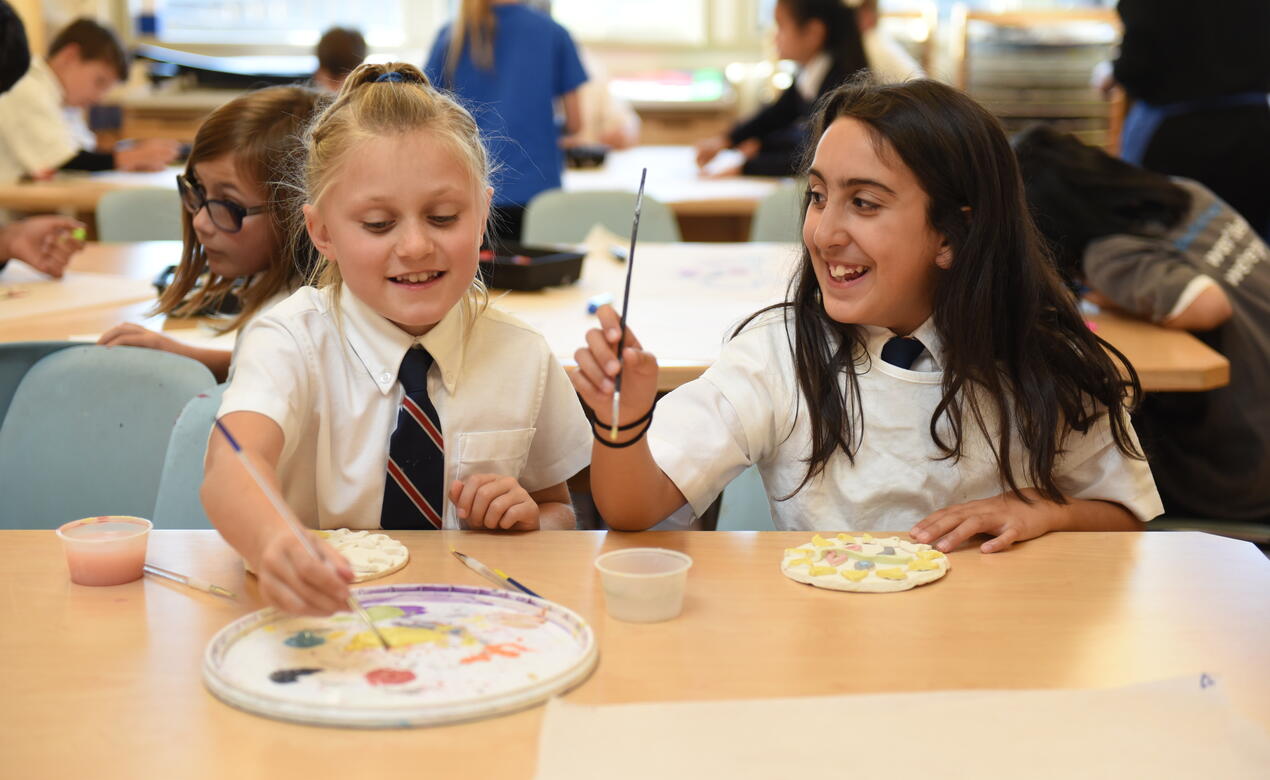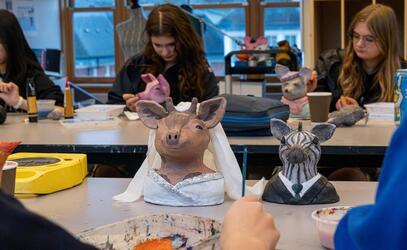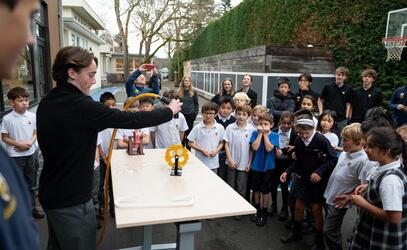
As the art specialist at the Junior School, I am reminded daily of how naturally and enthusiastically young children engage in the creative process. Honouring and fostering this innate ability for students to express themselves visually through the language of art is always at the forefront of my teaching. Encouraging them to trust their creative instincts while expanding and broadening their artistic horizons is both the challenge and beauty of teaching art to young learners. Whether we are working with clay, drawing, or painting, it is always my intention to educate, inspire and delight the students with each project.
I’d like to give you a glimpse into the learning that happens in the art room by sharing some of the experiences and processes that the Grade 5 students had during their recent painting unit where they were given the opportunity to experiment with a variety of materials, styles and techniques.
Sparking Imagination
The first project in the unit introduced them to the vibrant splatter art of Ralph Steadman. They began by enthusiastically creating their own splatter paintings. Each new splatter that hit the page enthralled them, and they were fully engaged and completely present. After the paintings dried, they were asked to use their imagination to incorporate and paint a bird into them using the splatters and drips as a guide.
They were delighted with the unexpected and intriguing birds that emerged, and when viewed all together, their paintings created a unique and playful flock of birds. The goal of this assignment was for them to feel the exhilaration and energy of working quickly and without an image, to spark their imagination, and as a springboard to the next project.
Perseverance and Dedication
We then moved on to look at the more realistic and colourful paintings in the book "The Beak Book" by Robin Page. Here the lesson took on the challenge of teaching young artists that imbedded in the process of making art is perseverance and dedication, and to strengthen their ability to sustain the moments of ambiguity and frustration that they will encounter during the process.
The students were asked to choose a bird, based on the images from the book, and to draw it as realistically as possible. To promote their skill development, we looked at how to break down the image into shapes and how to connect those shapes until they started to form their bird. This was a time of trial and error, of starting over, funny looking birds, and much perseverance. With sustained effort on their part and some encouragement and reassurance on my part, they drew wonderfully proportioned and realistic birds.
Now it was time to encourage them to take a creative risk and move beyond their comfort zone by drawing the same bird again – only much larger. After the groans subsided, the explanations on how they prefer to draw small and the declarations of “I can’t draw large!" ended, they rolled up their sleeves and started drawing their birds on large sheets of paper. The process began one more time, and much to their delight they successfully drew their birds large! The time and effort they had put into their work up until this point helped cement their commitment to the project and their dedication continued throughout the painting component of the assignment.
It is an amazing experience to be in the art room with the students while they are working on their assignments. The room resonates with creative energy. No matter how many times that I have been part of this process with students over the years, I always feel so fortunate to be able to watch the evolution of their artwork from start to finish. Whether or not the process finds its way to such well done and impressive paintings as the students had accomplished, it is always valuable and rewarding. This time it was also exhilarating, for me and the students, whose pride in their finished paintings was palpable.
Building Confidence to Take Artistic Risks
The third assignment focused on art history by introducing the students to the impressionist movement, new painting techniques, and acted as a counterbalance to the rigour of the previous assignment.
Using Claude Monet’s Water Lilies series as inspiration, the students painted their own water lily paintings in the style of the impressionists. No practise, just a diving into the experience and a lovely sense of satisfaction as they watched their impressionist painting slowly emerge and take shape from the dabs of paint and colour. They were truly delighted with the process and pleasantly surprised with their paintings.
Each assignment gave the students the opportunity to learn and expand on new skills, the confidence to take risks, to problem solve and play with their creativity.
Art and the natural lessons inherent in the creative process supports and encourages the growth of their artistic expression and contributes to the intellectual development of students. Honouring the natural creative spark that all children have is something that we can all do together. Providing children with the opportunity to expand their creative horizons can be as simple as giving them a dedicated work space at home where they can create freely, visiting galleries and museums with them, or even a visit to an art store where they can choose new materials to try at home. The goal is to encourage them to feel connected to their creativity, whether it is at home or in the art room.
Supporting and expanding each child’s capacity to express themselves visually, respecting their unique creative perspective, encouraging students to have fun with their creativity and hopefully inspiring a lifelong appreciation for the world of art is what art at the Junior School is all about.


